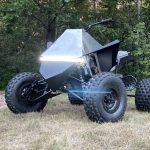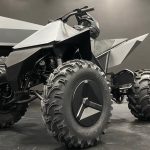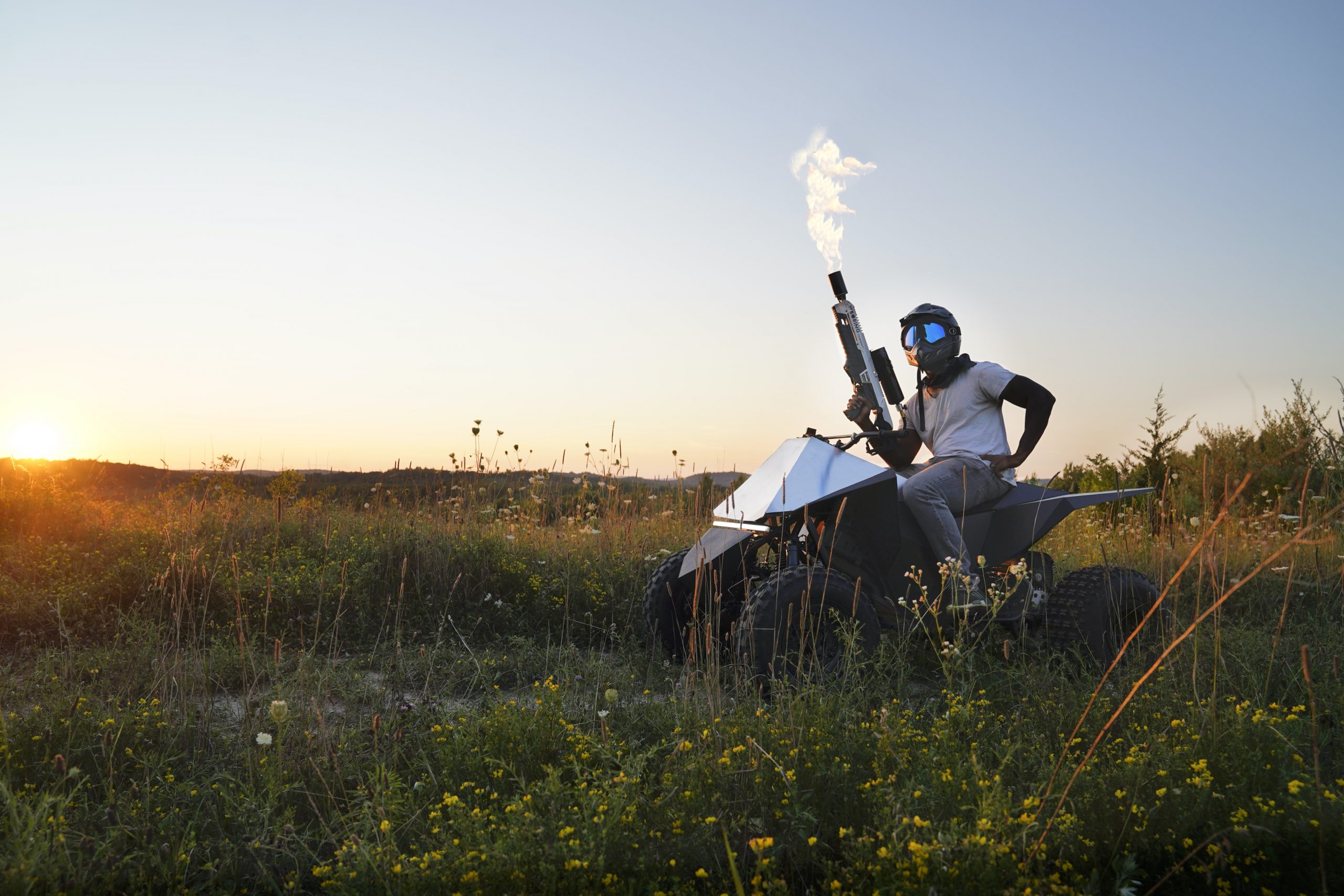
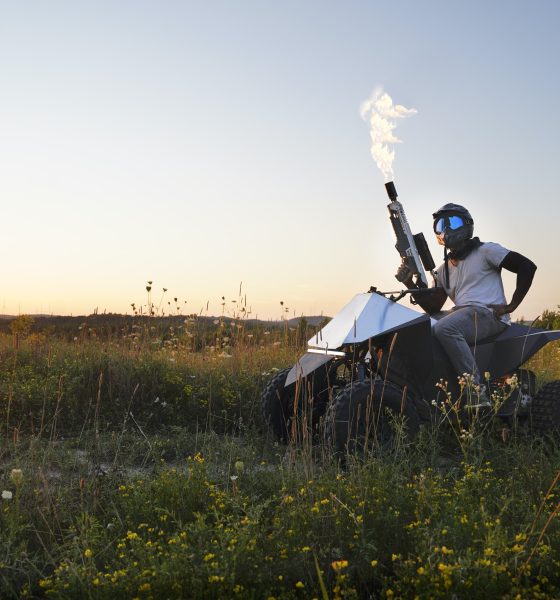
Lifestyle
Tesla Cyberquad replica rips past 100 mph with DIY electric powertrain
A Tesla Cyberquad replica from Rich Rebuilds has made its debut after hundreds of hours of effort, and its 102.5 MPH top speed is enough to turn heads of ATV enthusiasts everywhere.
When Tesla unveiled the Cybertruck in November 2019, a surprise came t when Elon Musk revealed that the company had also developed an ATV based on the look of the all-electric pickup. However, details about the Cyberquad have remained relatively sparse, and nobody has any idea when the four-wheeler could come to the market. Some are anxious to see the capabilities of the all-electric quad, so much so that they couldn’t wait.
One of the anxious parties was Rich Benoit of the widely-popular Rich Rebuilds YouTube channel. Benoit, along with the Department Head of Management for his team, Steven Salowsky, were two people who were so eager to see the Cyberquad that they took matters into their own hands. Rich and Steven built a Cyberquad replica using a Zero electric powertrain packed inside of a 2008 Yamaha Raptor 700.
Credit: Rich Benoit and Steven Salowsky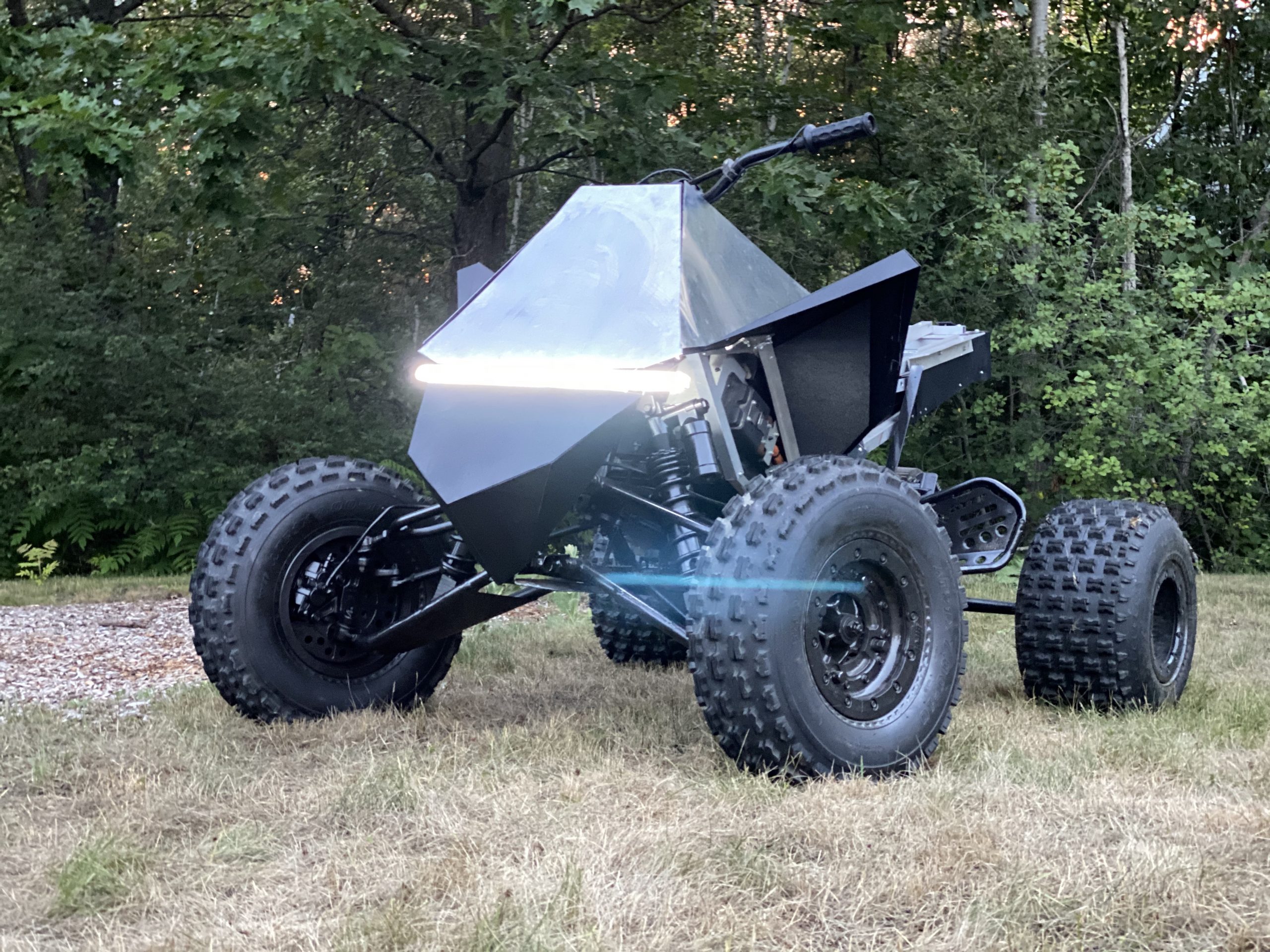
The project all started with an idea to build an electric ATV, and the Cyberquad was not the original inspiration. Stemming from their work doing a 1932 Ford Model A conversion with a Zero Motorcycle powertrain, Rich and Steven decided to put a similar power plant in a quad. Then, Steven offered to design it to replicate the Tesla Cyberquad.
A simple origami fold-up of the Cyberquad on Steven’s part was the project’s first stage. He told Teslarati that one day he starting folding and cutting pieces of paper for the project, which eventually led to a cardboard mock-up of the Cyberquad. Then, Rich and Steven, who was said to be “The Franz of the Operation,” (based on Tesla Chief Designer, Franz von Holzhausen) made another mock-up out of ABS plastic. The two were ready to begin building the Cyberquad replica.
Credit: Rich Benoit and Steven Salowsky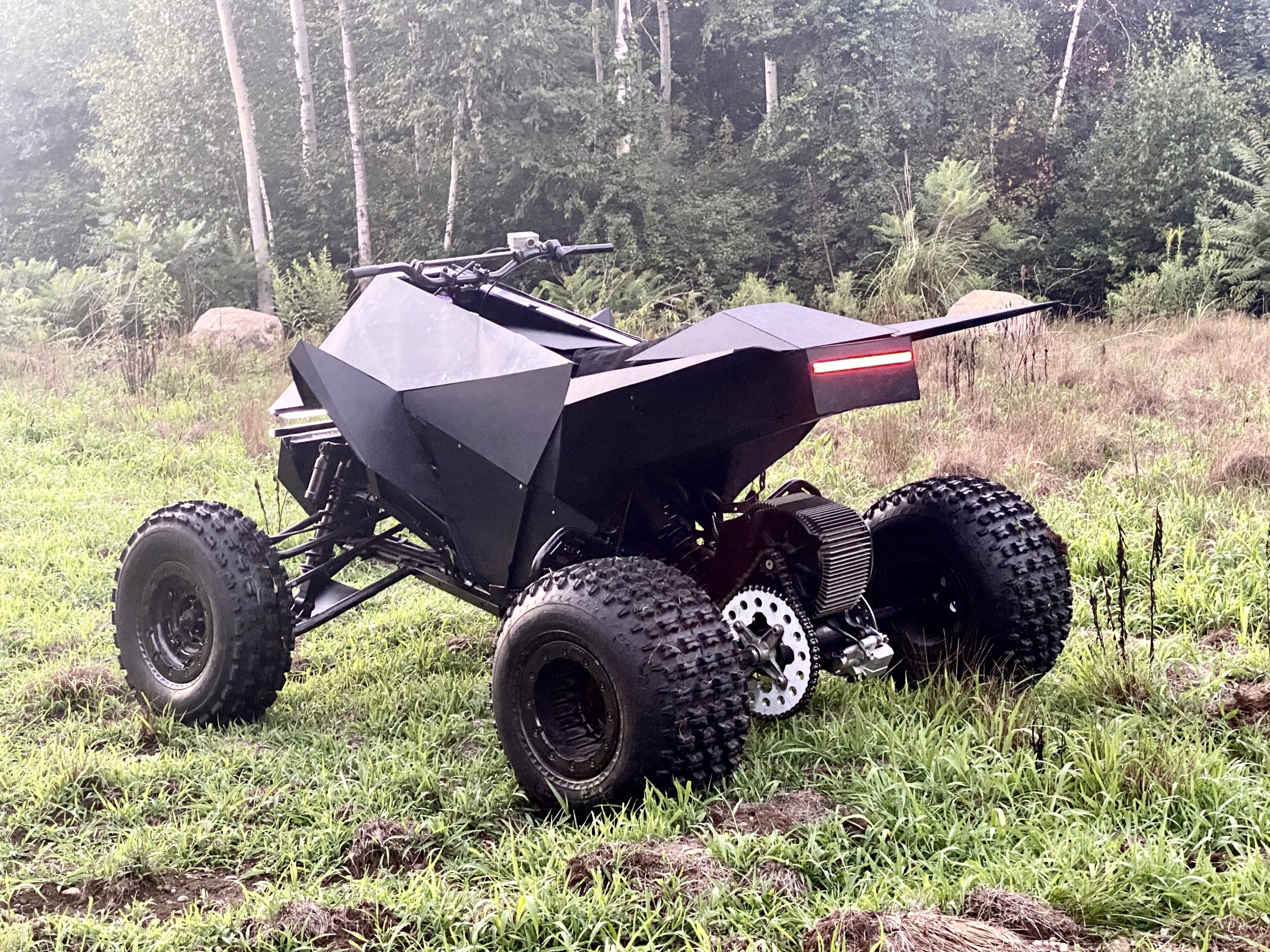
It started with buying a 2008 Yamaha Raptor 700, which the team purchased from a seller on the Facebook marketplace. Then, the powertrain that Rich and Steven used was one that was used by Zero, a manufacturer of electric motorcycles.
Steven also told Teslarati that it appears the real Cyberquad that Tesla showed in November also seems to use a Zero powertrain. The similarities between the look of the two ATVs appears to hint that Tesla could have used Zero’s powertrain as well.
- Credit: Rich Benoit and Steven Salowsky
- Credit: YouTube | HyperChange
Then came the fun part, putting the whole thing together and testing it on the road. Rich had wired the bike up with its new Zero motor powertrain and welded the new drive unit to the rear, and Steven restructured a new aluminum trestle frame onto the existing quad frame, and then formed and cut the new body.
The performance improvements of the Cyberquad built by Rich and Steven were exponential due to the Zero electric powertrain. Because of the modifications made to the powertrain and fabrication, the ’08 Raptor went from 0-60 in 5.4 seconds and a top speed of 75 MPH, to a Cyberquad clone with a 3.98-second 0-60, and a 102.5 MPH maximum speed.
The project, before factoring in 300 hours of work from the two colleagues, was about $18,000, Steven told Teslarati. Although a long and tedious process, the pair did a great job in recreating the Cyberquad with the limited photos and videos of the all-electric ATV. With the accuracy of the design and the impressive performance of the Cyberquad replica, it will be interesting to see how it stacks up against the real thing when Tesla releases it.
Check out Rich Rebuild’s video on the Cyberquad project below, and let us know what you think about it in the comments!
Disclaimer: “You are hereby notified that the stunts and tricks displayed in this video are performed by professionals in controlled environments, such as closed-circuit road tracks. Do not attempt to duplicate, re-create, or perform the same or similar stunts and tricks at home, as personal injury or property damage may result.”

Lifestyle
Tesla Model S Plaid battles China’s 1500 hp monster Nurburgring monster, with surprising results
There is just something about Tesla’s tuning and refinement that makes raw specs seem not as game-changing.

The Tesla Model S Plaid has been around for some time. Today, it is no longer the world’s quickest four-door electric sedan, nor is it the most powerful. As per a recent video from motoring YouTube channel Carwow, however, it seems like the Model S Plaid is still more than a match for some of its newer and more powerful rivals.
The monster from China
The Xiaomi SU7 Ultra is nothing short of a monster. Just like the Model S Plaid, it features three motors. It also has 1,548 hp and 1,770 Nm of torque. It’s All Wheel Drive and weighs a hefty 2,360 kg. The vehicle, which costs just about the equivalent of £55,000, has been recorded setting an insane 7:04.957 at the Nurburgring, surpassing the previous record held by the Porsche Taycan Turbo GT.
For all intents and purposes, the Model S Plaid looked outgunned in Carwow’s test. The Model S Plaid is no slouch with its three motors that produce 1,020 hp and 1,420 Nm of torque. It’s also a bit lighter at 2,190 kg despite its larger size. However, as the Carwow host pointed out, the Model S Plaid holds a 7:25.231 record in the Nurburgring. Compared to the Xiaomi SU7 Ultra’s record, the Model S Plaid’s lap time is notably slower.
Real-world tests
As could be seen in Carwow’s drag races, however, Tesla’s tech wizardry with the Model S Plaid is still hard to beat. The two vehicles competed in nine races, and the older Model S Plaid actually beat its newer, more powerful counterpart from China several times. At one point in the race, the Xiaomi SU7 Ultra hit its power limit due to its battery’s temperature, but the Model S Plaid was still going strong.
The Model S Plaid was first teased five years ago, in September 2020 during Tesla’s Battery Day. Since then, cars like the Lucid Air Sapphire and the Xiaomi SU7 Ultra have been released, surpassing its specs. But just like the Model Y ended up being the better all-rounder compared to the BYD Sealion 7 and the MG IM6, there is just something about Tesla’s tuning and refinement that makes raw specs seem not as game-changing.
Check out Carwow’s Model S Plaid vs Xiaomi SU7 drag race video below.
Lifestyle
500-mile test proves why Tesla Model Y still humiliates rivals in Europe
On paper, the BYD Sealion 7 and MG IM6 promised standout capabilities against the Model Y.

BYD is seeing a lot of momentum in Europe, so much so that mainstream media has taken every opportunity to argue that the Chinese automaker has beaten Tesla in the region. But while BYD sales this year in Europe are rising and Tesla’s registrations remain challenged, the raw capabilities of vehicles like the Model Y are difficult to deny.
This was highlighted in a 500-mile challenge by What Car? magazine, which showed that the new Tesla Model Y is more efficient, cheaper to run, and more reliable than rivals like the BYD Sealion 7, and even the nearly 400 KW-charging MG IM6.
Range and charging promises
On paper, the BYD Sealion 7 and MG IM6 promised standout capabilities against the Model Y. The Sealion 7 had more estimated range and the IM6 promised significantly faster charging. When faced with real-world conditions, however, it was still the Model Y that proved superior.
During the 500-mile test, the BYD nearly failed to reach a charging stop, arriving with less range than its display projected, as noted in a CarUp report. MG fared better, but its charging speeds never reached its promised nearly-400 kW charging speed. Tesla’s Model Y, by comparison, managed energy calculations precisely and arrived at each stop without issue.
Tesla leads in areas that matter
Charging times from 25% to 80% showed that the MG was the fastest at 17 minutes, while Tesla and BYD were close at 28 and 29 minutes, respectively. Overall efficiency and cost told a different story, however. The Model Y consumed 19.4 kWh per 100 km, compared to 22.2 for MG and 23.9 for BYD. Over the full trip, Tesla’s charging costs totaled just £82 thanks to its supercharger network, far below BYD’s £130 and MG’s £119.
What Car? Magazine’s testers concluded that despite BYD’s rapid sales growth and the MG IM6’s seriously impressive charging speeds, Tesla remains the more compelling real-world choice. The Model Y just offers stability, efficiency, and a proven charging infrastructure through its Supercharging network. And as per the magazine’s hosts, the Model Y is even the cheapest car to own among the three that were tested.
Watch What Car? Magazine’s 500-mile test in the video below.
Lifestyle
Tesla Cybertruck slapped with world’s least intimidating ticket, and it’s pure cringe
One cannot help but cringe and feel second-hand embarrassment at the idea of a person just driving around with a stack of these babies.

A Cybertruck parked at Stanford Shopping Center in California was recently hit with what might be the most try-hard piece of paper ever slipped under a wiper blade: a “fake citation” accusing the driver of supporting a “fascist car.”
The note, shared on X by Tesla staff program manager Ryan Torres, quickly made the rounds on X, where it quickly gained attention as an example of how not to protest.
The world’s least intimidating ticket
According to the citation, the supposed “violation” was “driving a fascist car.” The remedial action? Take the bus, call an Uber, or ride a bike. The note also dubbed Elon Musk a “chainsaw-wielding Nazi billionaire.” Now, protests against Tesla and Elon Musk have become commonplace this year, but one cannot help but cringe and feel second-hand embarrassment at the idea of a person just driving around with a stack of fake anti-Tesla/Musk citations.
Torres pointed out the irony himself in his post on X. Tesla currently employs over 140,000 Americans, and SpaceX has put the U.S. firmly back at the top of space technology. As Torres put it, maybe the person behind the world’s least intimidating ticket should “read a book on innovation before vandalizing” other people’s property.
Peak performative clownery
Not to mention that the fake ticket’s logic collapses under its own weight. EVs like the Cybertruck are literally designed to reduce emissions, not “destroy the economy.” If anything, Tesla has bolstered the United States’ economy by fueling jobs in engineering, manufacturing, and clean energy. It’s not the first time a Tesla has been the target of vandalism or politically charged notes, but this one stands out for sheer cringe value.
Torres summed it up neatly: “Peak clownery.” On that point, at least, the citation earns full marks. In a way, though, perhaps cringe fake tickets are not as bad as the literal firebombs that were being thrown at Tesla stores and cars earlier this year because some critics were gleefully misinformed about Elon Musk.
